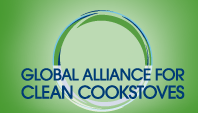The Global Alliance for Clean Cookstoves has released the second report in its annual series designed to recap the activities of the Alliance and its partners, analyze global progress toward providing cleaner cooking technology and fuel, and identify trends in this area.
The report, '2013 Results Report: Sharing Progress on the Path to Adoption of Cleaner and More Efficient Cooking Solutions,' highlights eight Country Action Plans that were launched in 2013.
 21 October 2014: The Global Alliance for Clean Cookstoves has released the second report in its annual series designed to recap the activities of the Alliance and its partners, analyze global progress toward providing cleaner cooking technology and fuel, and identify trends in this area. The report, titled ‘2013 Results Report: Sharing Progress on the Path to Adoption of Cleaner and More Efficient Cooking Solutions,’ highlights eight Country Action Plans that were launched in 2013.
21 October 2014: The Global Alliance for Clean Cookstoves has released the second report in its annual series designed to recap the activities of the Alliance and its partners, analyze global progress toward providing cleaner cooking technology and fuel, and identify trends in this area. The report, titled ‘2013 Results Report: Sharing Progress on the Path to Adoption of Cleaner and More Efficient Cooking Solutions,’ highlights eight Country Action Plans that were launched in 2013.
The section on ‘Focus Country Views’ sets the scene in eight countries: Bangladesh, China, Ghana, Guatemala, India, Kenya, Nigeria and Uganda. Based on survey data, almost all stoves in Bangladesh are fueled by dung, while Kenya uses almost entirely wood and Uganda relies on charcoal. In many other countries multiple fuels are used simultaneously. Respondents in China note that giving stoves away free actually leads to lower adoption and usage rates than when the end-user is asked to pay at least a portion of the cost.
These and other observations are combined with actions the Alliance is taking in each country, from launching market surveys and partnering with government agencies on pilot programs, to creating national awareness campaigns and initiating co-payment or credit models.
The report also gives an overview of Alliance activities at the global level. The partners report manufacturing 11.7 million stoves in 2013, a 22% increase over 2012. An even greater growth in distribution (75%) was reported, at 14.3 million stoves. A regional analysis reveals that 9.2 million of these stoves were distributed in the focus countries. In addition, 75% of all models were reported as being tested. In gender considerations, many partners report employing women, but note that there is room to increase women’s participation in manufacturing/production, finance and after-sales activities.
The online survey that informed the 2013 report was designed, administered and analyzed by Forest Trends’ Ecosystem Marketplace. The partners surveyed include cookstove and fuel designers, manufacturers, distributors, testing organizations, researchers, local implementing partners, consultants, carbon project developers, multilateral institutions, investors, donors, and other organizations. [Publication: 2013 Results Report: Sharing Progress on the Path to Adoption of Cleaner and More Efficient Cooking Solutions] [Global Alliance for Clean Cookstoves Reports & Research Webpage]